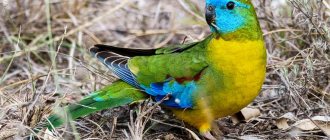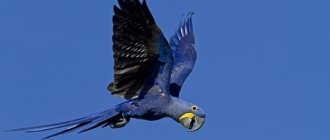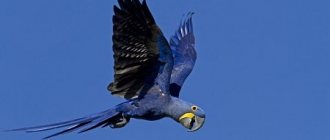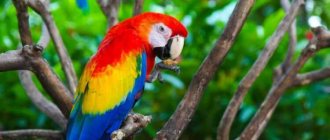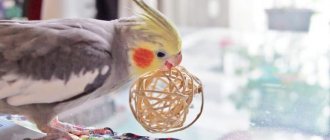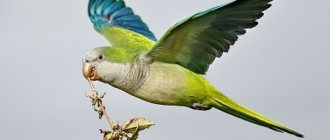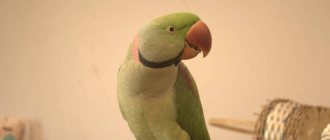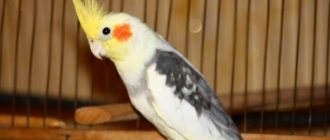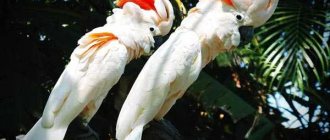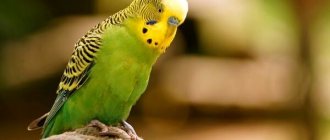- home
- Parrot
- Kinds
05/19/2019 The grassy parrot is a suitable option for people who want to choose a pet that is more original and unusual than a budgie. Despite some similarities in appearance and size, these two breeds are completely different in their behavior and character. In order for your pet to feel comfortable in the house and live a long life, you should study the conditions in which it is accustomed to living in nature.
Habitat
In nature, grass parrots inhabit the Australian continent and adjacent islands, especially Tasmania. They live in the southern, southeastern, central and western parts of the continent. Various species of this genus are found in areas with different landscapes: forests, eucalyptus groves, savannas, barren and semi-desert steppes, meadows, swamps, rocky areas, as well as near bays and lagoons.
Grass parrots rarely fly into the air and are almost never found in trees. These birds lead a mainly terrestrial lifestyle, hiding among grasses where they search for seeds and insects. Feathered birds move nimbly between plant stems and quickly run along the ground.
Captivity
The grass parrot lends itself well to captivity. These birds are quite unpretentious and quickly get used to it. Breeding conditions are the same for all representatives of the genus, only there may be slight differences in the diet.
Cage and accessories
Grass parrots can be kept in an aviary or in a spacious cage. Since these birds lead a terrestrial lifestyle, the area of their homes is more important than the height. The best choice is a rectangular cage measuring 90-150×60-90×60-90 cm (LxWxH) with a flat bottom and smooth walls. Inside the cage should be placed:
In addition, a booth should be installed in one of the corners of the cage, in which the bird can hide in case of fear.
For your information. Clean the cage as dirty as possible. Any uneaten wet food is removed every evening and the bedding is replaced with fresh bedding every few days. Once a month, the cage and accessories are thoroughly washed.
If you've decided on a complicated relationship with birds as pets and find common canaries and budgies boring, consider parakeets. Their friendly disposition and bright plumage will quickly win the hearts of their households.
This is a small bird - an adult specimen usually reaches only 25 cm, with very bright, beautiful plumage. Most birds have a predominant color of green in various shades. The bird's homeland is Australia and the adjacent island of Tasmania. Under natural conditions, these parrots most often live in eucalyptus forests with butterfly grass. They feed on grass seeds, small berries and insects.
Symptoms of diseases
In the first days of your budgie's stay in a new place, you do not need to immediately start raising it. First you need to establish close contact with the bird. It should take a little time. Also, for several weeks after purchasing a parrot, you need to carefully monitor its general behavior. Some actions may indicate that the bird is sick and needs specialist help. Then caring for the parrot will require more careful care.
So, what behavior can tell an owner that his pet is unwell? Firstly, if he doesn't eat well. Secondly, he drinks fluids very often. Thirdly, he moves little around the cage, mostly sits in one corner. Fourth, he looks sleepy. Fifthly, it is in a sitting position with its wings lowered and ruffled.
If such symptoms are noticeable, it is better to consult a veterinarian for advice. After all, its future life will depend on how to care for a parrot. Animals and birds are not things; they cannot simply be thrown away the first time you don’t want to keep or care for them.
Peculiarities
Unlike many of their cousins, grass parrots mainly move on the ground and fly only in exceptional cases. In nature, they are well versed in thick grass and prefer to fly only to the height of bushes. To keep them at home all the time, it is recommended to purchase a spacious room at least 1 meter long.
Grass parrots are quite friendly and easy to tame. Despite the fact that the bird is in constant motion, it does not make excessive noise. Grass parrots reproduce well in captivity - the female can lay eggs 1-2 times a year. The breeding age is about 8-9 months, but experts do not recommend breeding birds earlier than a year later.
In order for the birds to feel comfortable, it is not recommended to place more than one pair in one enclosure, as adult males begin to be hostile towards each other.
Memorable appearance
At the moment, 7 subspecies are classified as grass parrots. They all have characteristic external differences and common features. Thus, the predominance of green color in the plumage is considered a feature that unites all subspecies. The exception is the pink-bellied subspecies, which does not have a single shade of green in its plumage.
An adult grass parrot reaches about 23 centimeters in length. It has a small curved beak designed for catching small insects, picking fruits and extracting seeds. The parrot's head is small, depending on its species, it can be decorated with spots of color that contrasts with the main plumage.
The wings are medium in size and poorly developed, so the bird flies short distances, taking breaks. Some subspecies have a brightly colored abdomen, while others have a breast or wings. Grass parrots differ from their counterparts in having well-developed legs. Since most of their lives they move on the ground practically at a run, their legs are much stronger than their wings. With their help, they can cross uneven terrain, ditches and swampy areas.
How to maintain?
Since these birds originate from the tropics, conditions in their captivity should be close to natural. The room with the enclosure should be warm and draft-free. The optimal temperature is +20 degrees Celsius, and the humidity should not be less than 60%. Activity in grass parrots occurs during the day. During the day the bird is not very active, but towards sunset it begins to sing with its trills, which are not very loud, but rather in a pleasant and melodious voice.
That is why in the evening hours it is worth taking care of additional lighting. This bird is very shy, so the transition from daylight to evening light should be smooth. The sudden onset of darkness can put the bird in a stressed state. It is believed that a soft whistle can calm a restless bird, but loud sounds, on the contrary, are very exciting and irritating. With proper care, grass parrots in captivity live on average 12-15 years, and in some cases up to 20 years.
Price
The cost of grass parrots depends on the type. Popular species can be bought for 3,500-7,000 rubles, but rare and endangered species (for example, the golden-bellied parakeet) are not found on the open market.
Parrots are kept by bird lovers all over the world. These birds have an attractive appearance, calm character and unique behavior. They are not difficult to maintain, do not make noise and quickly become tame. With proper care, these birds can live up to 20 years. If you liked the article or have something to add, then leave your comments and also join our VKontakte group.
What to feed?
At home, parrots eat a mixture of grains. Food for canaries, oats and other grains, millet, and seeds are quite suitable. The main thing is not to overfeed the birds. An adult bird needs about one and a half tablespoons of feed per day. Parrots love to eat finely chopped or grated fruits and vegetables, as well as various greens.
In the first months of life, chickens should be fed animal protein. It is found in various insects: moths, worms and others.
Exercises
Bourke's parrots are less active than most other parrots, but they require 2 to 3 hours outside of their cage per day in a supervised play area.
These birds enjoy long, horizontal flights, so provide a safe flying environment—without other animals, ceiling fans, or open doors or windows.
Your Burka parrot will enjoy a variety of toys. Offer plastic toys with bells in bright colors and household items that can be chewed on, such as egg cartons.
Varieties
There are 7 species of grass parrots in total, each of which has its own unique coloring. Let's look at each of these types in more detail.
Pink-bellied
Rosewood parrot, also known as burqa. Scientific name: Neophema bourkii. The size of the bird is about 23 cm, the length of the tail is about 10 cm. The plumage of this specimen is brown, the abdomen is colored red-pink. The female has white feathers on her cheeks, while the male has a blue spot on his forehead. In nature, pink-bellied parrots nest in tree hollows. The female can lay 3-5 eggs at a time, which she incubates for 2-3 weeks.
The hatched chicks remain in the nest for about a month, after which they are completely ready for independent life and leave the nest. This species was introduced to Europe in the 19th century and became so popular that at the beginning of the 20th century it was already on the verge of extinction. Therefore, Australian authorities banned their export. The population is currently being renewed.
Azure
Azure parrot, scientific name Neophema pulchella. The size of the bird is the same as that of the previous species. The color of the males is also quite bright. The back is deep green, and the feathers on the belly are chicken-yellow. On the head is a cap made of delicate turquoise feathers. The wings are two-colored: closer to the base, the feathers are reddish-brown, and at the ends of the wings, as if to match the cap, there are sky-blue gloves. The legs are light pink and the beak is asphalt gray. The female cerulean parrot is easily distinguished by its modest clothing.
The main color of females and males is dark green, the abdomen is also yellow, but the color is not as intense as that of males. Females have no red shades at all. There are white spots on the inside of the wings. Blue parrots also nest in tree hollows, lay 5-8 eggs, fly and run quickly.
When at rest, the bird chirps quietly. He makes sounds like squeaking or loud chirping when he is worried or unhappy about something.
Golden-bellied parrot
Some sources also refer to this species as the orange-bellied or golden-bellied. Scientific name: Neophema chrysogaster. Found on the islands of Tasmania and the King Islands. This concerns a critically endangered species whose trade is prohibited. The size of the golden parrot does not exceed 20 cm. The main color of the male is emerald green, there is a blue spot on the forehead with a bluish tint, the cheeks are yellowish, the chest and abdomen are protectively marbled. There is a bright orange spot on the lower abdomen, from which the species gets its name.
The feathers are dark purple in the folds of the wings, and females have a white stripe on the inside, which males do not have. In nature, they prefer to settle on the sea coast, in places with low vegetation. They nest on eucalyptus trees in late autumn or early winter. One combination usually contains from 4 to 6 eggs. It takes 3 weeks to hatch and the chicks leave the nest after 5 weeks.
Bluewing
Scientifically called Neophema chrysostoma. A rare and endangered species, it is included in the list of the Convention on the Prohibition of the Sale of Endangered Species of Flora and Fauna, and therefore is practically absent from pet stores. It can only be found in some nurseries. The body size of the blue-winged parrot is standard, the main color is also green.
On the forehead and in the tail area there are small yellow spots, the same on the bird’s cheeks. A thin blue stripe on the forehead, the same coloring and feathers of the wings. The wings are dark brown on the outside, the tail is light yellow on the inside, gradually becoming gray-green. Traditionally, the coloring of females is less intense than that of males.
Decorated or elegant
Ornamented or elegant, in Latin Neophema splendida. The body size is standard, the predominant color is green with an olive tint. The eyebrows and wing folds are dark blue, and the tail is blue with a grayish tint in the middle and pale yellow at the edges.
Males and females can be distinguished by a pale orange patch on the lower abdomen. The nester mainly feeds on plant matter and builds nests on branches or stumps. The female lays up to 5 eggs once a year in early autumn. In captivity, birds live more than 10 years.
Rocky
Some sources refer to this species as stoneflies. Scientific name: Neophema petrophila. It is rarely found in the home, as it is an endangered species protected by law in its historical homeland. The size of the stone parrot is slightly more than 20 cm, the main color is marsh green, the body is yellow, and reddish fluff is slightly noticeable on the abdomen. The eyebrow area is blue, with a smooth transition to blue. The tail is complex in color - blue-green above, yellow below. The wings are blue at the break and blue at the edges.
Females are traditionally less colorfully dressed but have a white stripe on the inside of their wings. The feathers on the legs and beak are gray. In nature, they live in close proximity to water bodies, in rocky places with sparse vegetation. They fly poorly and only for short distances, preferring to hide in thick grass. They build their nests in mountain basins.
Redbreast
This species is considered perhaps the most beautiful of all grass parrots. Because of its special color it is also called glossy. In the scientific literature, this species is called Neophema splendida. With a standard body size, the red-eared parrot's tail length reaches 17 cm! The man has an ornate, shiny blue cap and a light purple scarf around his neck. The upper part of the bird - the back and tail - are green, and the lower part is multi-colored: the abdomen and lower tail feathers are yellow, the abdomen is bright yellow, the body is bright scarlet.
The wings are black with a blue tint at the ends and covered with blue feathers on top. The feet are neutral beige and the beak is bluish-black. As with other species, the female's coloration is much more modest than that of the male. And it has a white stripe on the inside of its wing. Parrots of this breed prefer low-lying areas and often settle on farms and gardens. They prefer to gather in herds of up to 20 individuals, and establish nests in late summer.
This species is very rare in nature, with only about 200 individuals recorded at the end of the 20th century. Protected by law.
To learn what you can and cannot give to grass parrots, watch the video below.
Golden-bellied (Neophema chrysogaster)
Orange-bellied Parrot (Orange-bellied Parakeet) has been on the IUCN Red List of Critically Endangered Species (CR) since 2000. It is considered very rare, so the bird is protected from capture and distribution at the legislative level.
The variety of these grass parrots has an extremely small number. Recently it became reliably known that they nest only on one type of tree and always in the same small area. This territory is shrinking every year; the reasons for the decrease in habitat are still unclear.
Scientists predict that it will take about 5 more years to completely disappear from the wild. For this reason, full-scale efforts are underway to save the population through planned capture and targeted breeding in captivity.
These birds live in eucalyptus and tropical forests bordering on vast heathlands. They nest in hollows and feed on grass and seeds of sedge, which grows on heather heaths.
In golden-bellied parrots, the color is a mixture of colors that is pleasant to the human eye: green, blue, yellow. In addition to the main colors, there are also less noticeable inclusions of other shades. Adult males have a prominent two-tone blue stripe on the forehead, a green-blue rump with yellow side feathers that are visible in flight, and an orange patch on the belly. Adult females have a color identical to that of males, but duller. Also, the orange spot on their belly is somewhat smaller, and their tail is greener. Young golden-bellied parakeets are similar in color to adult females, which can be easily distinguished by their faded plumage and yellow-orange beak and cere. The Golden-bellied Parrot is distinguished from the Blue-winged and Elegant by its dark grass-green wings, while the top of the leading edge is narrow and dark blue.
These are very noisy parrots and when they talk to each other there is a continuous buzz around the flock. The signal of danger for them is loud exclamations, similar to metallic ringing.
Golden-bellied parakeets breed only on Malaleuca tea trees and only in Birch Bay in the southwest of the island. Tasmania. After breeding, the birds migrate to the mainland with a short stop on the island. King and winter in the south-eastern territories of eastern Australia in New South Wales. The annual average number of wintering birds in Victoria, South Australia and Bass Strait from 1979 to 1990 ranged from 77 to 129 birds. In 2005 there were 150 individuals. Since then, the population has gradually declined: in 2007 there were 48 birds, and in 2010 only 50. According to known data, during the breeding season of 2008-2009 and 2009-2010, only 12 and 13 parrots fledged, respectively.
Currently, about 300 birds are kept in captivity in three artificial nurseries in different parts of the country. At the same time, every year some of the individuals are released into the wild in Birch Bay, but the released birds were never able to create a second viable colony. Therefore, the program to restore the population of golden-bellied grass parrots continues.
The main reason for the decline in population is considered to be fragmentation and degradation of the habitat, as well as the development of agriculture and industry. In addition, an outbreak of PBFD viral activity was observed in 2015. The virus affects the beak and feather cover. Golden-bellied parrots also compete with finches and starlings. There are known deaths by accident, for example, when meeting with predators (foxes and cats), during storms when flying to the island. Tasmania and back to the mainland.
I will briefly tell you about what is being done to preserve golden-bellied parrots.
In accordance with Appendix I of the CITES convention, a group was formed in 1980 to restore the population of golden-bellied parakeets. This team is engaged in research activities regarding the habitat of these birds, breeding habits, causes of extinction and much more. In addition, one of the tasks of this group is to preserve feeding grounds on the island. Tasmania, o. King and in Victoria. The main center for the golden-bellied parrot's captive breeding program is Healesville Sanctuary in Melbourne. Today there are approximately 160 individuals there, and work on catching parrots does not stop. Every year a batch of birds is released into the wild to nest on the island. Tasmania.
In addition, there is the so-called South Australian Golden-bellied Parrot Habitat Conservation and Restoration Project, which is funded by the NHT Natural Heritage Trust. This project was launched in 2008. Like all similar projects, its goal is ultimately to create a closed area with the most favorable conditions for the life and reproduction of these birds.
In 2010, the Golden-bellied Parakeet Restoration Group prepared another 18-month action plan, which was supported by a $260,000 grant from the Australian government. During the 2015 virus outbreak, the government allocated $525,000 to fight the virus.
As you can see, very active actions are being taken to save parrots of this species and, if you believe the statements of representatives of wildlife conservation in Australia, these actions are very successful, and the population trend is currently growing very slowly. So there is no need to worry about golden-bellied parrots, let's move on to the remaining 6 species.
Habitat
In the wild, grass parrots can be found in southern and south-eastern Australia, as well as on the western continent and central Queensland, Victoria, New South Wales, Tasmania and the Bass Strait Islands.
These birds prefer grass-rich forests with undergrowth, dry eucalyptus savannas, barren and semi-desert steppes with sparse vegetation and thorny bushes, meadows, swamps, bays, lagoons and rocky areas.
Each species of grass parrot inhabits an area with a certain landscape, but they all lead a “terrestrial” lifestyle.
The flights of grass parrots are short and short, the birds spend a lot of time on the ground in dense grass.
The name of this species is associated with its habits: grass parrots spend most of their lives searching for various seeds in thickets of grass. Sometimes flocks of grass parrots can be found in the fields and gardens of farmers, but there are no complaints about their harmfulness.
After spending a lot of time on the ground, grass parrots have adapted to quickly navigate over potholes and ditches, as well as running quite quickly.
Several subspecies of grass parrots are endangered and protected by law in Australia.
The main food of parrots in nature is various seeds of meadow and steppe grasses: wild canary, kangaroo grass, clover; They also willingly eat the fruits of wild bushes, fruits, and sometimes even insects.
Description and types of grass parrots
Grass parrots belong to the genus (Neophema), which includes seven species (although some researchers recognize Neophema bourki as a separate species):
All species of grass parrots have artificially bred new colored varieties.
The most popular among fans are: pink-bellied, azure, brilliant and graceful parrots.
The bird's body size is 21-25 cm, the main color is green with different shades, except for the pink-bellied ones - the plumage is completely green.
Common parrots are crepuscular birds, active in the morning and evening hours. If during the day it is almost impossible to see and hear them, then towards evening the birds happily begin to fly around the cage, flying from one side of the cage to the other using the lower rods.
Despite the fact that parakeets have some external similarities with budgies, their behavior, habits and relationships with each other are strikingly different.
Azure parrots are very popular as pets. The nature of the birds is calm, balanced and well tamed.
Species such as porcini mushrooms are prone to obesity, so be very careful when choosing a menu for the bird and its participation in daily flights. They are also easy to tame and readily establish contact with people.
Parrots with glossy grass are considered the most beautiful. This is one of the favorite parrots of breeders. The birds are endowed with all the positive qualities of this species and are treated well from the first minutes of meeting them.
Reproduction
Adult parrots have pronounced sexual dimorphism. When a bird's wing opens, a white stripe appears on the inside of the female; males do not have this.
However, due to the frequent mixing of species to obtain new colors, such a difference in some cases may be inexpressible or completely absent. In this case, amateurs resort to other methods of determining sex (observation of behavior, DNA test).
Males become more aggressive during the breeding season, so for safe breeding it is better to keep the pair in a separate enclosure. Success in breeding can be achieved not only by placing steam indoors outdoors, but also by creating optimal conditions indoors.
Puberty in grass parrots occurs at the age of 8-9 months, but it is better to prepare a pair after one year of age. During the mating season, the male begins to court the female, becomes affectionate and “invites” her to the nest.
Nesting in birds occurs 2-3 times a year from August to December (this applies to wild parrots). For domestic grass parrots, it is better to provide conditions in spring and summer.
The female incubates 3 to 6 eggs for about 20 days, after which the pair raises the chicks for a month. Keep in mind that parakeet chicks are very skittish! Clean the cage thoroughly, being careful not to disturb the babies.
Keeping grass parrots at home
For a long time, bird lovers struggled with the problem of ensuring normal conditions for keeping grass parrots in captivity and their further reproduction. It got to the point that this species of parrot decided to be considered intolerant of life in a cage, very capricious and weak. However, the hard work of some ornithologists was not in vain.
Grass parrots came to Russia in 1975 from Germany (GDR).
Grass parrots should be kept in spacious cages or aviaries, in a warm, well-ventilated room, but without drafts.
One of the main enemies of grass parrots is draft!
Artificial lighting
The room itself should be bright, with access to sunlight.
Grass parrots are cold-blooded birds, so it is important to pay attention to artificial lighting in the cage.
Use two additional lighting modes:
Grass Parrots are timid birds and suddenly being plunged into darkness can make them anxious and stressed. Moreover, at the end of the day they become very active, and turning off the lights will not allow the birds to lead a natural and healthy lifestyle.
Conditions in captivity
A comfortable air temperature for parrots is 18-20 ° C; air humidity should also be controlled, it should not be lower than 50-60%. Cold and damp are destructive for birds!
Grass parrots, like other species, should be allowed out for walks. This will protect the birds from many diseases and help you bond with them.
The cage, or rather its size, is also responsible for the good health of the bird. Grass parrots like to spend a lot of time on the ground, so the cage should be as long as possible. If you plan to breed birds, choose a house for a couple with dimensions: length 100-150 cm, height up to 100 cm, width 50-80 cm.
Grass parrots love to run on the ground, so of course it is better if the birds have room to jog and make short flights from perch to perch.
Parrots are very sensitive during adaptation (the first days at home), but subsequently become unpretentious and kind roommates.
If the birds are not yet fully accustomed to the house or they are scared, try whistling softly. The parrots will noticeably calm down, and your interaction with them will help them adapt faster.
It is very important to create optimal conditions first so that you can enjoy your birds for many years to come. With good breeding habits, these birds can live up to 20 years.
Nutrition
In nature, the main food of grass parrots is seeds and young shoots of various herbs. At home, food should also be fresh and of high quality.
The first six types of grain should always be present, the rest depend on the season and the natural needs of the birds (breeding season, molting, active flights, feeding chickens). Cereals can be served in varying degrees of maturity, as well as sprouted and soaked.
For greens, birds love dandelion, endive, rail, oregano, lettuce, spinach, quinoa, clover and wormwood. We also offer fruits, vegetables, berries, young ears of corn, sunflower caps, branches of bushes and trees with buds. To maintain young birds, they are given mealworm larvae, eggs and cottage cheese.
It's fair to say that once you decide to buy a pair of grass parrots, you won't regret it. Rarely was anyone content with one feathered family, and later they always got several more.
Grass parrots are unpretentious, calm and very peaceful birds. You will have a lot of fun watching them and participating in their lives.
Owner reviews
Our pet Richie has become a real member of the family in 2 years. This is a calm and intelligent bird, imitates various sounds, but does not speak.
Ivan
We bought Archie only a few months ago, but we have already become very attached to the bird. This smart creature does not cause us any trouble, but we often go to the dacha and at first we took him with us, but as it turned out, this is real stress for him, so we began to leave him at home under the supervision of neighbors.
Olga
It is also useful to read: Kea parrot
